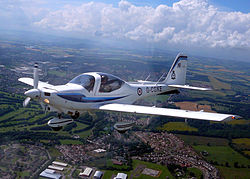This article needs additional citations for verification .(November 2016) |
| University of Birmingham Air Squadron RAFVR | |
|---|---|
 | |
| Active | 1941–present |
| Role | Training, Recruiting |
| Part of | No. 6 Flying Training School RAF |
| Garrison/HQ | RAF Cosford |
| Motto | Scientia Dabit Alas (Latin: Knowledge Will Give Us Wings) [1] |
| Equipment | Grob Tutor T1 |
| Commanders | |
| Officer Commanding | Sqn Ldr J Watson [2] |
| Senior Student | APO Thomas Rayden [3] |
| Insignia | |
| Identification symbol | One blue, double headed lion rampant |
The University of Birmingham Air Squadron, commonly known as UBAS, is a squadron within the Royal Air Force established on 3 May 1941. It is based at RAF Cosford, Shropshire, and flies a fleet of six Grob Tutors. In 2009 the squadron upgraded the aircraft to the Grob Tutor EA which has an advanced avionics suite. The squadron has three flights, A, B and C; each with a student Flight Commander who holds the rank of acting pilot officer. UBAS is also the parent squadron of 8 Air Experience Flight, who jointly fly UBAS' Tutor fleet.
Contents
- History
- Commanding officers
- Alumni
- Flying
- Student Leadership Team
- Incidents
- See also
- References
- External links
A Squadron Leader is the Commanding Officer, while UBAS also has several other Qualified Flying Instructors, a Ground Training Instructor, 15 civilian support staff who are contracted from Babcock, plus an adjutant and two civilian admin staff. There are some 70 members from the University of Birmingham, Birmingham City University, Aston University, Coventry University, Warwick University, Keele University, Wolverhampton University Staffordshire University, Worcester University, and Harper Adams University. [4]
Students volunteer to join UBAS at their university's Freshers' Fair and then undergo a selection process. If successful they are attested and join the Royal Air Force Volunteer Reserve. All Students are given the rank of Officer Cadet, and are issued with a uniform. UBAS activities include flight, sports, military and leadership training, adventurous training, charity and community work and a vibrant social scene. [5] The scope of UBAS, like other University Air Squadrons is to let young people experience life in the Royal Air Force and to develop their skills in the fields mentioned. [6]

